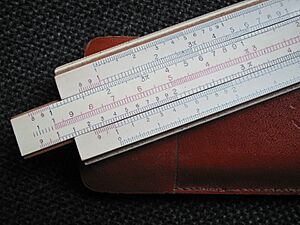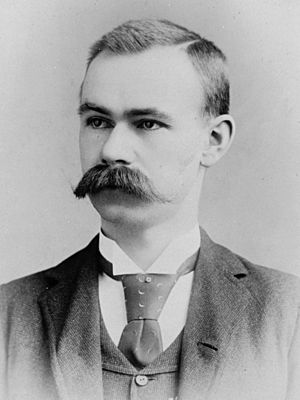Information technology facts for kids
Information technology (or IT) is all about using technology to handle information. This includes creating, storing, sharing, and using all kinds of information. Think of it as everything from business facts and phone calls to pictures, videos, and even new ways of sharing data we haven't thought of yet!
Today, IT covers many different areas of technology. It's much broader than it used to be.
Contents
A Look Back at IT History
The story of information technology can be split into four main periods. Each period is known for the main type of technology used to solve problems like getting information in, processing it, getting it out, and sharing it.
- Premechanical Age
- Mechanical Age
- Electromechanical Age
- Electronic Age
The Premechanical Age: 3000 B.C. – 1450 A.D.
This was a time before machines. People found clever ways to communicate and keep records.
Writing and Alphabets: Early Communication
At first, humans only talked and drew pictures.
- Around 3000 B.C., the Sumerians in Mesopotamia (now southern Iraq) invented cuneiform. This was one of the first writing systems.
- About 2000 B.C., the Phoenicians created symbols for sounds.
- The Greeks later added vowels to the Phoenician alphabet. The Romans then gave letters Latin names, creating the alphabet we use today.
Paper and Pens: How Information Was Recorded
- Sumerians used a sharp tool called a stylus to scratch marks into wet clay.
- Around 2600 B.C., Egyptians started writing on papyrus plants.
- About 100 A.D., the Chinese made paper from rags. This is the basis for how paper is made even today.
Books and Libraries: Storing Information Permanently
- Early "books" were kept by religious leaders in Mesopotamia.
- The Egyptians stored their writings on scrolls.
- Around 600 B.C., the Greeks started folding papyrus sheets. They bound them together, much like modern books.
The First Numbering Systems
- The Egyptians had a system where vertical lines meant 1-9. A U or circle was 10, a coiled rope was 100, and a lotus blossom was 1,000.
- The first numbering systems like ours, using place values, appeared in India between 100 and 200 A.D. They used nine digits.
- The idea of zero was developed around 875 A.D.
The First Calculators: The Abacus
The abacus was one of the earliest tools used to do calculations. It helped people add and subtract numbers.
The Mechanical Age: 1450 – 1840
This period saw the invention of machines that could help with information.
The First Information Explosion
- In 1450, Johann Gutenberg from Germany invented the movable metal-type printing press. This allowed books to be made much faster.
- This led to a huge increase in books. Book indexes and page numbers became common.
Early "Computers" Were People
- Before machines, a "computer" was actually a person! This was someone whose job was to work with numbers and do calculations.
Slide Rules and Early Calculating Machines
- In the early 1600s, an English clergyman named William Oughtred invented the slide rule. This was a mechanical tool used for multiplication and division.
- Later, machines like the Pascaline and Leibniz's Machine were invented. These were early mechanical calculators.
The Electromechanical Age: 1840 – 1940
During this time, people learned to use electricity. This was a huge step forward because information could now be turned into electrical signals.
The Start of Telecommunication
- The Voltaic Battery was invented in the late 1700s. It provided a steady source of electricity.
- The telegraph appeared in the early 1800s.
- In 1835, Samuel Morse developed Morse code. This used dots and dashes to send messages over telegraph lines.
- In 1876, Alexander Graham Bell invented the telephone.
- Soon after, people discovered that electrical waves could travel through space. This led to the invention of the radio by Guglielmo Marconi in 1894.
Electromechanical Computing
- Herman Hollerith and IBM: Herman Hollerith (1860–1929) created machines that used punched cards to process data in the 1880s. His company later became IBM.
- Mark I: Howard Aiken, a student at Harvard University, built the Mark I. It was completed in 1942. This huge machine was 8 feet tall, 51 feet long, and weighed 5 tons! It used about 750,000 parts.
The Electronic Age: 1940 – Today
This is the age of modern computers, using electronics instead of mechanical parts.
Early Electronic Computers
- In the early 1940s, the first electronic computers used vacuum tubes. These were large and generated a lot of heat.
- Scientists Eckert and Mauchly built the ENIAC. This was one of the first electronic computers. However, its programs were fixed and could not be easily changed.
The First Stored-Program Computers
- In the early 1940s, Mauchly and Eckert started designing the EDVAC (Electronic Discreet Variable Computer).
- John von Neumann wrote an important report in 1945 called "The Report on the EDVAC." This report described the idea of a "stored-program" computer. This meant the computer could store its instructions (program) in its memory, just like data.
- British scientists used this report and moved quickly.
- Max Newman led a team at Manchester University. Their Manchester Mark I started working in June 1948. It became the first computer to store its program.
- Maurice Wilkes, a British scientist at Cambridge University, finished the EDSAC (Electronic Delay Storage Automatic Calculator) in 1949. This was two years before EDVAC was ready. EDSAC became the first stored-program computer used by many people.
First Commercial Computers: UNIVAC and LEO
- In the late 1940s, Eckert and Mauchly began developing the UNIVAC (Universal Automatic Computer).
- The first UNIVAC was delivered to the Census Bureau in 1951.
- However, a machine called LEO (Lyons Electronic Office) started working a few months before UNIVAC. LEO became the world's first computer used for business.
The Four Generations of Digital Computing
Computers have changed a lot over time. We often talk about four "generations" of digital computing.
The First Generation (1951–1958)
- These computers used vacuum tubes as their main parts.
- They used punch cards to put in and store data.
- Rotating magnetic drums were used for storing data and programs inside the computer.
- Programs were written in very basic languages like Machine code or Assembly language.
The Second Generation (1959–1963)
- Transistors replaced vacuum tubes. Transistors were much smaller, faster, and used less power. They were invented at AT&T's Bell Laboratories in the 1940s.
- Magnetic tape and disks started to replace punch cards for storing data.
- Magnetic cores (tiny donut-shaped magnets) became the main way to store data inside the computer.
- New, easier-to-use programming languages like FORTRAN and COBOL were developed.
The Third Generation (1964–1979)
- Individual transistors were replaced by integrated circuits. These chips held many transistors.
- Magnetic tape and disks completely took over from punch cards for external storage.
- New memory types, like MOS memory, started to replace magnetic core memory. These also used silicon chips.
- Operating systems were developed. These programs managed the computer's resources.
- More advanced programming languages like BASIC were created.
The Fourth Generation (1979–Present)
- This generation uses very large-scale integrated circuits (LSIs and VLSICs).
- Microprocessors became common. These chips contained the entire brain of a computer (the CPU or Central Processing Unit).
- This led to personal computers (PCs) for home use, like the Apple II and IBM PC.
- The Apple II was released in 1977 by Steve Wozniak and Steve Jobs.
- The first Apple Mac came out in 1984.
- The IBM PC was introduced in 1981. It came with MS-DOS (Microsoft Disk Operating System).
- New software products like VisiCalc and Microsoft Word appeared.
- Graphical User Interfaces (GUIs) arrived in the early 1980s. These let you use a mouse and click on icons, instead of typing commands.
- MS Windows first appeared in 1983, but became popular with version 3 in 1990.
- Apple's GUI on the first Mac debuted in 1984.
What is the Field of Study?
If you want to work with information technology, you might study for a Bachelor of Information Technology (BIT or BInfTech). This usually takes three to five years.
- This degree focuses a lot on computers and technology.
- It's different from a Computer Science degree. In IT, you also learn about management and information science. You might have fewer math classes.
- A computer science degree focuses on the scientific side of computing. An IT degree focuses more on how computers are used in business and communication. This is important for areas like electronic commerce and e-business.
Many jobs for software developers or programmers ask for a Computer Science degree. But if you want to be a network administrator or database manager, an Information Technology degree is often needed.
People with an IT background can do many tasks. They help with processing, storing, and sharing information between computers, mobile phones, and other electronic devices. The IT field is all about managing large amounts of different information safely. It also makes sure this information can be reached through many different systems, both local and worldwide.
Related pages
Images for kids
-
A program on paper tape.
-
A replica of the Zuse Z3 computer at the Deutsches Museum in Munich. The Zuse Z3 was the first programmable computer.
-
The Antikythera mechanism, an ancient Greek device considered the first mechanical analog computer.
-
Punched tapes were used in early computers to represent data.
See also
 In Spanish: Tecnología de la información para niños
In Spanish: Tecnología de la información para niños














